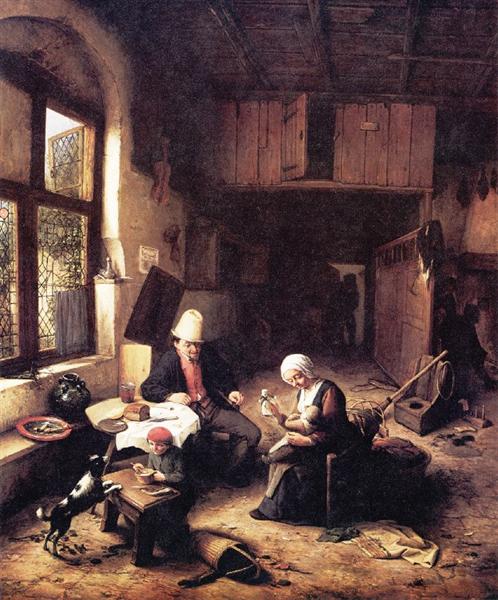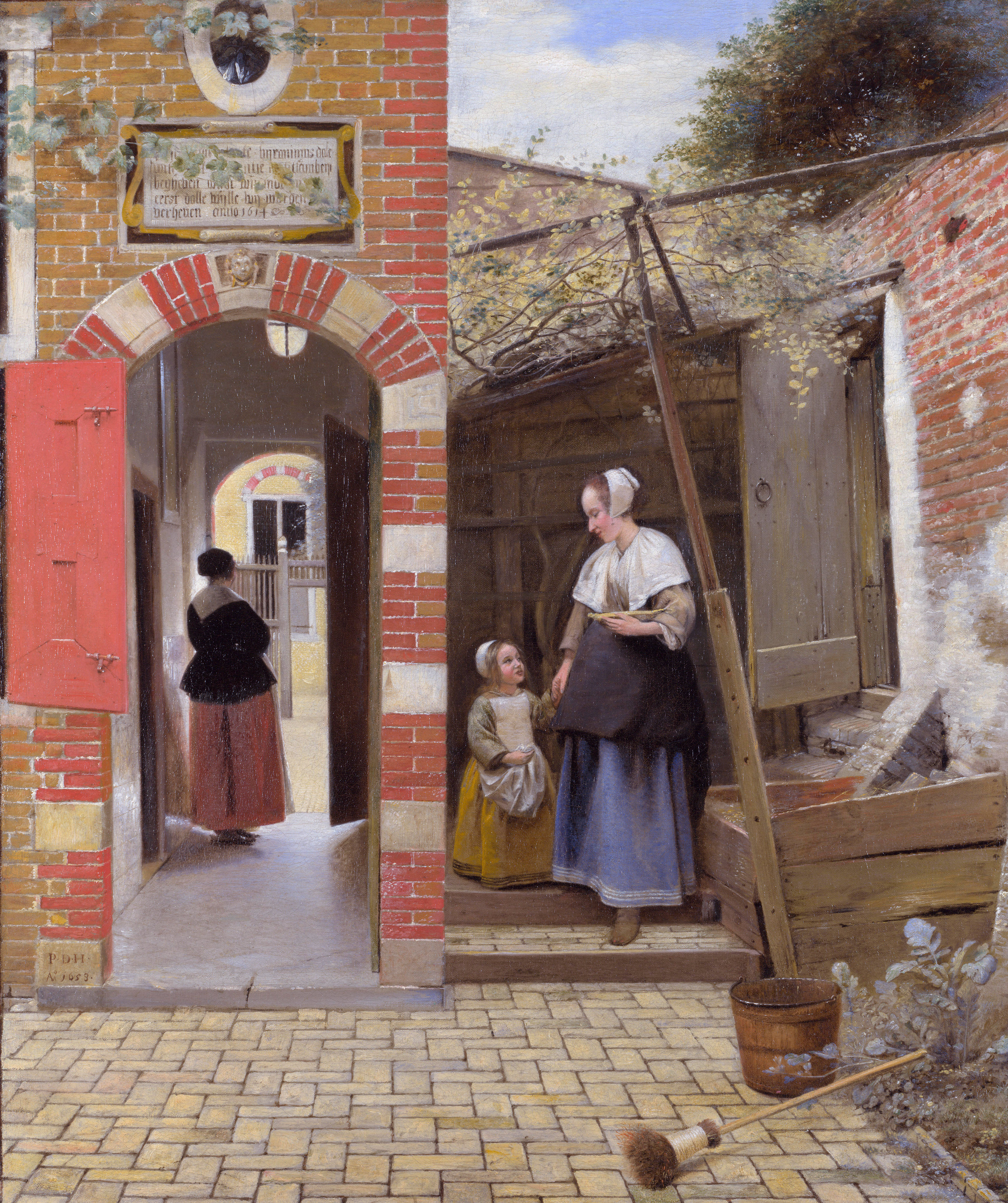"The Music Lesson" by Johannes Vermeer returns to the
Netherlands this autumn for the first time in twenty years. This
masterpiece, part of the British Royal Collection, was last on display
in the Mauritshuis in 1996, as part of the major Johannes Vermeer
exhibition. The painting will be the highlight of this autumn’s
exhibition At Home in Holland: Vermeer and his contemporaries from the British Royal Collection. The exhibition opened to the public on the 29th of September.

"The Music Lesson" by Johannes Vermeer is installed at the exhibition At Home in Holland. Vermeer and his Contemporaries from the British Royal Collection that will open to the public 29 September 2016, Royal Collection Trust © Her Majesty Queen Elizabeth II 2016. Photographer: Piet Jacobson
"The Music Lesson"
"The Music Lesson" by Johannes Vermeer, Royal Collection Trust / © Her Majesty Queen Elizabeth II 2016.
"The Music Lesson" is one of the
rare 36 surviving works by Johannes Vermeer. This painting dates from
1660-1662, and shows a woman and a gentleman beside a virginal. Above
the instrument hangs a mirror, which reflects the foot of Vermeer's
easel. The The painting was acquired by King George III of England in
1762, when it was attributed to Frans van Mieris the Elder. Only later
was it recognised as a masterpiece by Vermeer.
Mauritshuis itself has three works by Vermeer
Diana and her Nymphs,
View of Delft
and Girl with a Pearl Earring,
but its collection lacks a genre piece by the artist. That’s why the museum is delighted to have the opportunity of showing a fourth Vermeer for a time.
The exhibition at The Mauritshuis contains works by masters such as Gerard ter Borch, Gerrit Dou, Pieter de Hooch, Gabriël Metsu and Jan Steen, which are regarded as some of the most important Dutch genre paintings in the Royal Collection.
Produced during the Dutch ‘Golden Age’, when the Netherlands was at the forefront of commerce, science and art, these works represent a high point in ‘genre painting’ – ordinary scenes of everyday life rendered in extraordinary detail. Renowned for their exquisite depiction of space and light, Dutch artists of the period also included humorous or moralising messages in their work for the contemporary viewer to decode.
Johannes Vermeer is perhaps the most highly regarded genre painter of his generation, despite only 34 paintings being attributed to him today.
In Lady at the Virginals with a Gentleman, early 1600s, Vermeer uses the horizontal grid of the floor tiles to create the illusion of depth within the painting. The viewer's eye is drawn into the room, where a woman stands with her back to the observer and a man at her side appears to sing. Their relationship is ambiguous and has been the subject of much debate. However, clues such as the inscription on the lid of the virginal – music is a companion in pleasure, a remedy in sorrow – suggest that there might be a romantic association between the figures.
The shared pleasures of music and love underlie the subject-matter of
Gabriel Metsu’s The Cello Player, c.1658, in which a female figure is greeted adoringly by a pet dog, while her suitor tunes his cello.
The Neglected Lute, c.1708, by Willem van Mieris presents a similar theme, but this time in the form of a seduction. A woman in a sumptuously decorated room eats oysters and drinks from a delicate glass, while a lute, an erotic symbol to a contemporary audience, rests on the floor at her side.
Scenes of provincial Dutch life, in taverns and cottages and at village fetes, were popular subject-matter for artists.
Adriaen van Ostade's The Interior of a Peasant's Cottage, 1668, is a sympathetic image of peasant family life, with a mother cradling her baby and an older child eating obediently at a table, while their doting father looks on. The perspective of the composition leads the viewer's eye into the depths of the room, where other figures appear from the shadows.
A Girl Selling Grapes to an Old Woman, c.1658, by Frans van Mieris the Elder, shows a young girl selling produce door to door from a wheelbarrow. The rich variety of fruit and vegetables on offer advertises the fertility of the Dutch soil and reflects the development of horticulture during the Golden Age.
In one of Pieter de Hooch’s early works, A Courtyard in Delft, c.1657, a woman sits spinning in shadow while another crosses from sunlight into the shade carrying a jug, a dramatic bright-blue sky overhead. The artist skilfully records all aspects of the scene, from the patchy whitewash on the brickwork to the two towers in the background.
The quiet, contemplative character of De Hooch's composition contrasts with the strange artificiality of
Ludolf de Jongh's A Formal Garden: Three Ladies Surprised by a Gentleman, c.1676, in which the four foreground figures appear to be actors in a play.
The importance of trade in the Netherlands during the Golden Age is reflected in
Gerrit Dou's The Grocer's Shop: a Woman Selling Grapes, 1672. Here two women busily weigh goods in a shop selling exotic imported items such as lemons and sponges. As if caught in an unguarded moment, another in the background, holding a coffee pot, looks directly at the viewer. In Willem van Mieris's An Old Man and a Girl at a Vegetable and Fish Stall, 1732, beneath the baskets of dried herrings, walnuts and gingerbreads, a rat nibbles an apple unnoticed by the figures in the shop, providing a humorous touch for the viewer.
Diana and her Nymphs,
View of Delft
and Girl with a Pearl Earring,
but its collection lacks a genre piece by the artist. That’s why the museum is delighted to have the opportunity of showing a fourth Vermeer for a time.
The exhibition at The Mauritshuis contains works by masters such as Gerard ter Borch, Gerrit Dou, Pieter de Hooch, Gabriël Metsu and Jan Steen, which are regarded as some of the most important Dutch genre paintings in the Royal Collection.
Produced during the Dutch ‘Golden Age’, when the Netherlands was at the forefront of commerce, science and art, these works represent a high point in ‘genre painting’ – ordinary scenes of everyday life rendered in extraordinary detail. Renowned for their exquisite depiction of space and light, Dutch artists of the period also included humorous or moralising messages in their work for the contemporary viewer to decode.
Johannes Vermeer is perhaps the most highly regarded genre painter of his generation, despite only 34 paintings being attributed to him today.
In Lady at the Virginals with a Gentleman, early 1600s, Vermeer uses the horizontal grid of the floor tiles to create the illusion of depth within the painting. The viewer's eye is drawn into the room, where a woman stands with her back to the observer and a man at her side appears to sing. Their relationship is ambiguous and has been the subject of much debate. However, clues such as the inscription on the lid of the virginal – music is a companion in pleasure, a remedy in sorrow – suggest that there might be a romantic association between the figures.
The shared pleasures of music and love underlie the subject-matter of
Gabriel Metsu’s The Cello Player, c.1658, in which a female figure is greeted adoringly by a pet dog, while her suitor tunes his cello.
The Neglected Lute, c.1708, by Willem van Mieris presents a similar theme, but this time in the form of a seduction. A woman in a sumptuously decorated room eats oysters and drinks from a delicate glass, while a lute, an erotic symbol to a contemporary audience, rests on the floor at her side.
Jan Steen, A Woman at her Toilet, 1663, Royal Collection Trust / © Her Majesty Queen Elizabeth II 2016By contrast, Jan Steen's A Woman at her Toilet, 1663, contains a moralising message. The viewer takes on the role of voyeur, observing through an archway a young woman on an unmade bed in a state of undress. A lute with a broken string, a skull, and a candle with its flame extinguished carry the warning that yielding to sensuality could lead to ruin.
Scenes of provincial Dutch life, in taverns and cottages and at village fetes, were popular subject-matter for artists.
Adriaen van Ostade's The Interior of a Peasant's Cottage, 1668, is a sympathetic image of peasant family life, with a mother cradling her baby and an older child eating obediently at a table, while their doting father looks on. The perspective of the composition leads the viewer's eye into the depths of the room, where other figures appear from the shadows.
A Girl Selling Grapes to an Old Woman, c.1658, by Frans van Mieris the Elder, shows a young girl selling produce door to door from a wheelbarrow. The rich variety of fruit and vegetables on offer advertises the fertility of the Dutch soil and reflects the development of horticulture during the Golden Age.
In one of Pieter de Hooch’s early works, A Courtyard in Delft, c.1657, a woman sits spinning in shadow while another crosses from sunlight into the shade carrying a jug, a dramatic bright-blue sky overhead. The artist skilfully records all aspects of the scene, from the patchy whitewash on the brickwork to the two towers in the background.
The quiet, contemplative character of De Hooch's composition contrasts with the strange artificiality of
Ludolf de Jongh's A Formal Garden: Three Ladies Surprised by a Gentleman, c.1676, in which the four foreground figures appear to be actors in a play.
The importance of trade in the Netherlands during the Golden Age is reflected in
Gerrit Dou's The Grocer's Shop: a Woman Selling Grapes, 1672. Here two women busily weigh goods in a shop selling exotic imported items such as lemons and sponges. As if caught in an unguarded moment, another in the background, holding a coffee pot, looks directly at the viewer. In Willem van Mieris's An Old Man and a Girl at a Vegetable and Fish Stall, 1732, beneath the baskets of dried herrings, walnuts and gingerbreads, a rat nibbles an apple unnoticed by the figures in the shop, providing a humorous touch for the viewer.
Gerard ter Borch (Zwolle 1617-Deventer 1681) A Gentleman pressing a Lady to drink c.1658-9,, Royal Collection Trust / © Her Majesty Queen Elizabeth II 2016.












